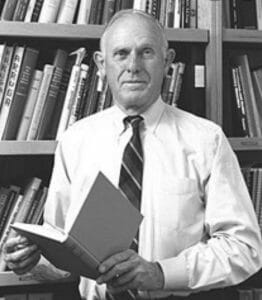A medical doctor, Scott had wide interests: he interned in surgery, and then narrowed that concentration to neurosurgery. But that wasn’t it either: he went on to do another residency in ophthalmology, finishing in 1961, when he was immediately hired as a Senior Scientist at the Smith-Kettlewell Eye Research Institute, where he also served as its Director from 1982-2004.
At one point he was working on a treatment for strabismus (a condition in which the eyes do not properly align with each other), which previously had been treated by surgery that fixed the problem but often had troubling side-effects. Scott got the idea for something less radical: use a paralytic to relax the specific muscle that was pulling one of the eyes off-center. After trying several different such substances, he discovered the military had isolated and purified botulinum type A, and got a sample. It worked great, and Scott dubbed it “Oculinum” (“eye aligner”). No drug company wanted to go through the work of making it, testing it, and going through the drug approval process in exchange for being able to sell it for a relatively rare condition, so Oculinum became an “orphan” drug — which brought it under the 1983 U.S. Orphan Drug Act, and Dr. Scott got FDA approval for Oculinum in 1989.
When treating people with it, doctors noticed an interesting, and positive, side-effect: in addition to fixing the eye condition, the drug smoothed out wrinkles, such as “crow’s feet.” More interested in research and treatment — Scott had to “decide if he wanted to be in the pharmaceutical business or be a research scientist.” He chose the latter, and sold rights to the drug to Allergan. “Nobody at Allergan understood how big a gold mine they were sitting on,” says David E.I. Pyott, who became the company’s CEO in 1989: that year, the company’s sales of the drug were $90 million. Why so much for an “orphan” drug? It was the crow’s feet effect: Allergan renamed the drug Botox — short for botulism toxin, an often deadly food poison — and cosmetic surgeons realized they could clear up wrinkles with injections, which only lasted a few months — and the patient would return for more. (“I think that’s a charming, slightly frivolous use,” Scott said in a 2002 interview. “But it’s not along the lines of what I was into, applications for serious disorders.”) By 2009, sales topped $1 billion. Botox has also proven effective for laryngeal spasms, making it difficult for people to speak; blepharospasm, where muscle contractions slam the eyes shut, effectively making the victim blind; and dystonia, sustained muscle spasms in limbs that (for instance) made walking difficult or impossible. Dr. Scott had predicted all of these uses, as they all had a common cause: severe and sustained muscle spasms.

But he didn’t predict that Botox could help migraine sufferers. That was noticed by Beverly Hills plastic surgeon William Binder, whose patients that he treated with Botox reported that their migraine headaches improved. Dr. Binder did the work in the 1990s to do a controlled study*, and the FDA finally approved Botox for migraine sufferers in 2010. In 2016, Dr. Scott was inducted into the American Society of Cataract and Refractive Surgery’s Ophthalmology Hall of Fame. He went on to teach, and watch Botox to be used 4.4 million times each year. “Life’s a mystery,” he said. “It’s dazzling, all the things that happen.” Dr. Alan Brown Scott died on December 16, at 89.
* Author’s Note: Although Dr. Binder had finished collecting data for his study on Botox use for migraine patients, a friend in common convinced him to take on one more migraine patient in the mid-90s: me. For just the cost of the drug, the cosmetic surgeon to Hollywood stars injected tiny bits of Botox into my forehead and scalp in 15-20 spots, and sure enough I could no longer lift my eyebrow on that side! It only helped my headaches a little bit — at that point I was getting 4-6 headaches per week — before it wore off after several months. I found that small doses of beta blockers (most notably propranolol and metoprolol) worked better at preventing my headaches, but it took over a year of daily use to be fully effective.
